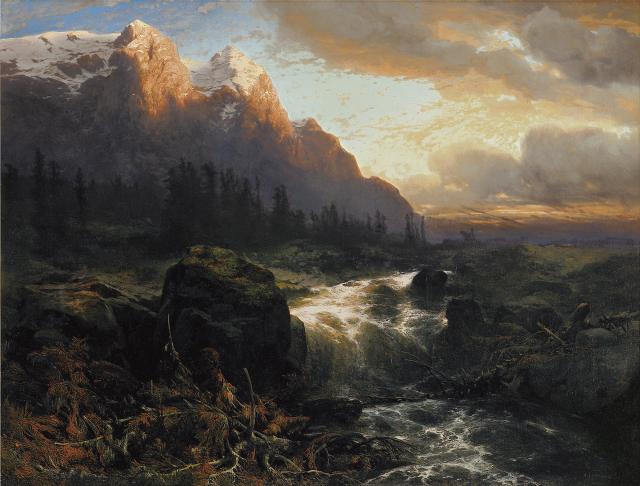The Rosenlaui valley brings together all the characteristics of a grandiose mountain landscape, from high-mountain pastures and cowsheds to craggy rocks and sparkling glaciers. And crowning it all are the gorges, which had already been sparking enthusiasm in admirers of nature and romanticism for over a century.
In 1835 Alexandre Calame makes the first of several stays in the Bernese Oberland, an area that fascinates him tremendously and proves to be a true source of inspiration. In 1853 he paints two versions of Souvenir de Rosenlaui (Souvenir of Rosenlaui), this oil on canvas and another on wood in a smaller dimension.
In this painting, Calame carefully recreates the landscape’s motifs using a naturalist technique. Two parts clearly stand out here between shadow and light. Above, a warm light envelops the peaks in the blue of heaven’s vault touched here and there with scattered cloud. By contrast, a dark mass that is structured by the jagged line of a forest extends to the foreground, where various branches of the fur trees have accumulated, painted in warm tones as well. The branches conjure up the untamed aspect of this natural setting, which is often exposed to the violence of the harsh, unforgiving weather. But Calame subtly carries over the light into this darker part, which allows him to lend movement and energy to the flow of the mountain stream rushing and tumbling through the landscape.
On the back of the canvas the following note was made, “View of the Wetterhorn and the Rosenhorn, in the foreground the Reichenbach. Painted at the behest of Her Imperial Highness, the Grand Duchess of Leuchtenberg. Finished in June 1853. A. Calame”. The work was therefore part of the imperial collection of the Grand Duchess of Leuchtenberg (1819-1876 / daughter of Nicholas I of Russia and wife of Maximilien de Beauharnais, the Duke of Leuchtenberg).
In 1835 Alexandre Calame makes the first of several stays in the Bernese Oberland, an area that fascinates him tremendously and proves to be a true source of inspiration. In 1853 he paints two versions of Souvenir de Rosenlaui (Souvenir of Rosenlaui), this oil on canvas and another on wood in a smaller dimension.
In this painting, Calame carefully recreates the landscape’s motifs using a naturalist technique. Two parts clearly stand out here between shadow and light. Above, a warm light envelops the peaks in the blue of heaven’s vault touched here and there with scattered cloud. By contrast, a dark mass that is structured by the jagged line of a forest extends to the foreground, where various branches of the fur trees have accumulated, painted in warm tones as well. The branches conjure up the untamed aspect of this natural setting, which is often exposed to the violence of the harsh, unforgiving weather. But Calame subtly carries over the light into this darker part, which allows him to lend movement and energy to the flow of the mountain stream rushing and tumbling through the landscape.
On the back of the canvas the following note was made, “View of the Wetterhorn and the Rosenhorn, in the foreground the Reichenbach. Painted at the behest of Her Imperial Highness, the Grand Duchess of Leuchtenberg. Finished in June 1853. A. Calame”. The work was therefore part of the imperial collection of the Grand Duchess of Leuchtenberg (1819-1876 / daughter of Nicholas I of Russia and wife of Maximilien de Beauharnais, the Duke of Leuchtenberg).
